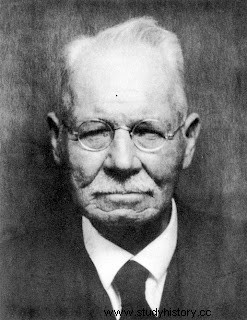 Max Uhle This society developed in one of the most difficult areas of the national territory; of subtropical climate, arid with deserts that surround the small valleys of the department of Ica, such as Río Grande, Ica, Pisco, somewhat far from the sea. The aforementioned rivers dry up in the winter season and increase their flow in summer, which conditions the geographical landscape that the population of Nazca inhabited. From these areas they expanded to the Chincha Valley, in the North; and even the Acari Valley (Arequipa), in the South.
Max Uhle This society developed in one of the most difficult areas of the national territory; of subtropical climate, arid with deserts that surround the small valleys of the department of Ica, such as Río Grande, Ica, Pisco, somewhat far from the sea. The aforementioned rivers dry up in the winter season and increase their flow in summer, which conditions the geographical landscape that the population of Nazca inhabited. From these areas they expanded to the Chincha Valley, in the North; and even the Acari Valley (Arequipa), in the South.The peasants, the main force of production, faced this geographical reality, and with collective work they achieved great economic and cultural development, which are divided into the hydraulic, astronomical technological advances and the community work of the ayllus. The Nazca culture, whose origins are found in the Paracas Culture that preceded it, was discovered by Max Uhle, who called it Proto Nazca. Its cultural center was the city of Cahuachi, the same one that is located in the valley of the Rio Grande, in the province of Nazca, in the department of Ica. Its area of influence was between Ica (valleys of Chincha, Pisco, Ica, Río Grande) and Arequipa (Acarí).
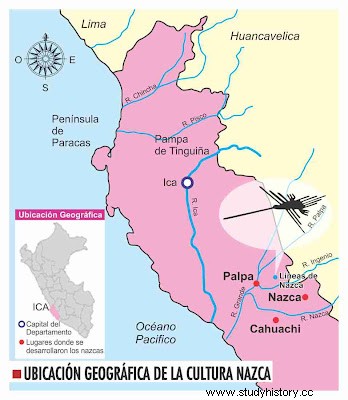 AGE: In the final period or Necropolis of the Paracas culture, art and textile techniques gained an unusual boom on the south coast, knowledge that was monopolized by specialists who settled in the Rio Grande valley from the 1st century A.D. to this society has precisely been called Nazca culture. Here, the military predominated in power and exercised control of the land, but they structured a theocratic-militaristic State. It developed autonomously until the 5th or 6th century, when they were invaded by the growing Wari Empire. Its decline was due to natural phenomena due to the fact that its territory was covered with sand carried by the winds, which also coincided with the arrival of the Wari in the region.
AGE: In the final period or Necropolis of the Paracas culture, art and textile techniques gained an unusual boom on the south coast, knowledge that was monopolized by specialists who settled in the Rio Grande valley from the 1st century A.D. to this society has precisely been called Nazca culture. Here, the military predominated in power and exercised control of the land, but they structured a theocratic-militaristic State. It developed autonomously until the 5th or 6th century, when they were invaded by the growing Wari Empire. Its decline was due to natural phenomena due to the fact that its territory was covered with sand carried by the winds, which also coincided with the arrival of the Wari in the region.ECONOMY: In a planned way with foresight, high hydraulic technology and organized in ayllus, they developed agriculture, achieving the cultivation of chili, lima beans, cotton, etc.; they fished the rich hydrobiological variety in the sea; They hunted the camelids and took advantage of their meat, their dung, their wool. Moreover, despite the dryness of their area, they managed to extract water from the subsoil through wells and filter galleries with a complex network of aqueducts, which allowed the groundwater to rise to the surface; then they moved the water resource to the fields through canals (Pangarabi and Majoro canal).
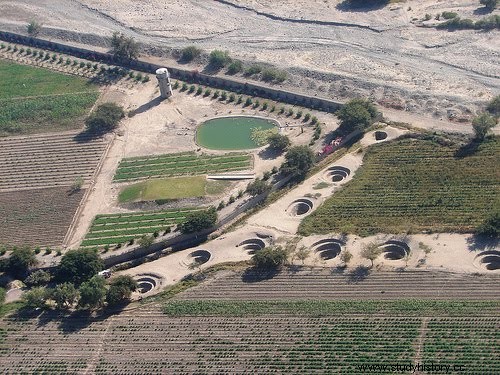 Underground aqueducts, Nazca Hydraulic technology Hydraulic networks:more than forty canals were built from different streams, generally along the riverbeds and sometimes passing under them. First, a series of wells were dug, located 20 or 50 m from each other, until reaching the aquiferous layer. They were then connected to underground canals and to other open ditches. The walls were reinforced with boulders placed one on top of the other and the slab roofs were supported by them. The walls had an average height of 70 cm and the ceilings a width of 60 cm. “The canal system filtered the water located at that level of the subsoil and transported it to puquios or reservoirs, from which the fields were irrigated, the wells, from which the canals were opened, are known as “eye” or respirators and They served to be able to enter to carry out the cleaning while they were not used, they were placed on slab covers. They reached between 3 and 7 m deep” (El Comercio – 2000). There is evidence of a commercial interrelation between Nazca and the Andean peoples of the south center, surely to provide charqui, olluco, potato, obsidian (volcanic stone), or also with the jungle border of Ayacucho where they had an enclave in what today is the town of Silvia and San Francisco, from where they supplied themselves with Amazonian products. The Nazca practiced trade with peoples of the southern highlands of Peru, specifically with the Huarpa from Ayacucho. This activity allowed them to obtain charqui, chuño, obsidian, supplies for their pottery, etc. Being in front of the coast they also practiced fishing and hunting. But agriculture was its most important economic activity. The main crops they grew were cotton, pallar and chili. The difficulties that his geographical environment represented led him to develop various irrigation techniques such as the construction of reservoirs, canals, underground aqueducts, etc. The underground channels were built in the following way. First, they dug wells located at a certain distance until they obtained subsoil water, and they were also used to clean the canals. Then, through underground channels, they connect the wells. The most important remains of underground aqueducts are those of Majoro, Pangarabi and Cantalloc.
Underground aqueducts, Nazca Hydraulic technology Hydraulic networks:more than forty canals were built from different streams, generally along the riverbeds and sometimes passing under them. First, a series of wells were dug, located 20 or 50 m from each other, until reaching the aquiferous layer. They were then connected to underground canals and to other open ditches. The walls were reinforced with boulders placed one on top of the other and the slab roofs were supported by them. The walls had an average height of 70 cm and the ceilings a width of 60 cm. “The canal system filtered the water located at that level of the subsoil and transported it to puquios or reservoirs, from which the fields were irrigated, the wells, from which the canals were opened, are known as “eye” or respirators and They served to be able to enter to carry out the cleaning while they were not used, they were placed on slab covers. They reached between 3 and 7 m deep” (El Comercio – 2000). There is evidence of a commercial interrelation between Nazca and the Andean peoples of the south center, surely to provide charqui, olluco, potato, obsidian (volcanic stone), or also with the jungle border of Ayacucho where they had an enclave in what today is the town of Silvia and San Francisco, from where they supplied themselves with Amazonian products. The Nazca practiced trade with peoples of the southern highlands of Peru, specifically with the Huarpa from Ayacucho. This activity allowed them to obtain charqui, chuño, obsidian, supplies for their pottery, etc. Being in front of the coast they also practiced fishing and hunting. But agriculture was its most important economic activity. The main crops they grew were cotton, pallar and chili. The difficulties that his geographical environment represented led him to develop various irrigation techniques such as the construction of reservoirs, canals, underground aqueducts, etc. The underground channels were built in the following way. First, they dug wells located at a certain distance until they obtained subsoil water, and they were also used to clean the canals. Then, through underground channels, they connect the wells. The most important remains of underground aqueducts are those of Majoro, Pangarabi and Cantalloc.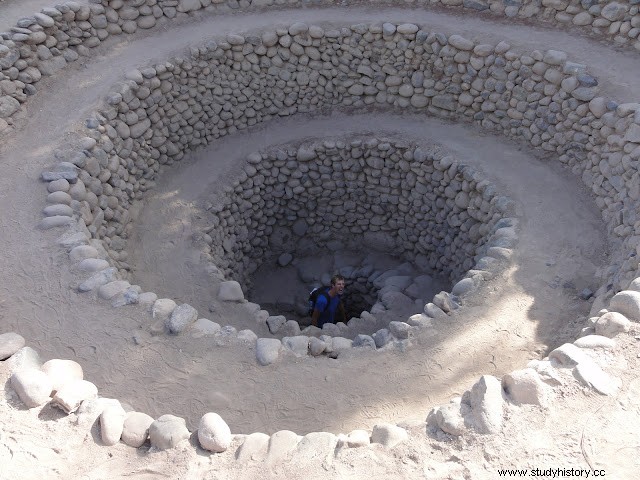 Puquios nazca SOCIAL ORGANIZATION: Julio C. Tello and Max Uhle found architectural remains where the cylindrical shape of the funerary niche can be seen – unlike the inverted cup type of the Paracas – but, the most impressive, are the richly decorated human remains of military figures. If we add to these the motifs of their vessels, we will see that they painted militarized characters, warriors and also priests of great size, in relation to the rest. From all this it follows that the privileged class, in Nazca, was made up of warriors and priests, developing a theocratic-militaristic state. Furthermore, the drawings of fishermen and peasants are small, and these humble characters are symbolized with the figure of lizards or as trophy heads, hanging from the vain image of a warrior. It cannot be denied that the social division of this culture was class-based, the popular class was at a disadvantage.
Puquios nazca SOCIAL ORGANIZATION: Julio C. Tello and Max Uhle found architectural remains where the cylindrical shape of the funerary niche can be seen – unlike the inverted cup type of the Paracas – but, the most impressive, are the richly decorated human remains of military figures. If we add to these the motifs of their vessels, we will see that they painted militarized characters, warriors and also priests of great size, in relation to the rest. From all this it follows that the privileged class, in Nazca, was made up of warriors and priests, developing a theocratic-militaristic state. Furthermore, the drawings of fishermen and peasants are small, and these humble characters are symbolized with the figure of lizards or as trophy heads, hanging from the vain image of a warrior. It cannot be denied that the social division of this culture was class-based, the popular class was at a disadvantage.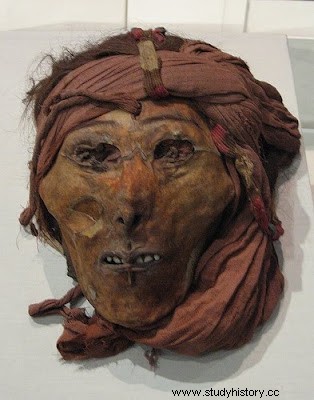
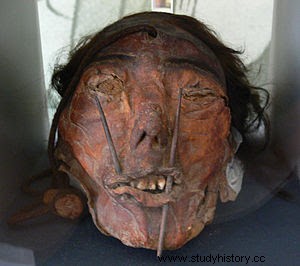 Trophy head In the tombs and in the Nazca ceramics, men appear carrying trophy heads, which would be spoils produced by war. It was a very widespread custom among them the mummification of heads, possibly of defeated warriors, it was thought that the greater the number of heads a warrior possessed, the greater the prestige, power and authority. Currently, when mummified heads of women and children are found, it is argued that they were used as offerings to their gods. The trophy heads present the lips closed and joined with cactus spines, in addition to a rope on the top of the skull used to transport it.
Trophy head In the tombs and in the Nazca ceramics, men appear carrying trophy heads, which would be spoils produced by war. It was a very widespread custom among them the mummification of heads, possibly of defeated warriors, it was thought that the greater the number of heads a warrior possessed, the greater the prestige, power and authority. Currently, when mummified heads of women and children are found, it is argued that they were used as offerings to their gods. The trophy heads present the lips closed and joined with cactus spines, in addition to a rope on the top of the skull used to transport it.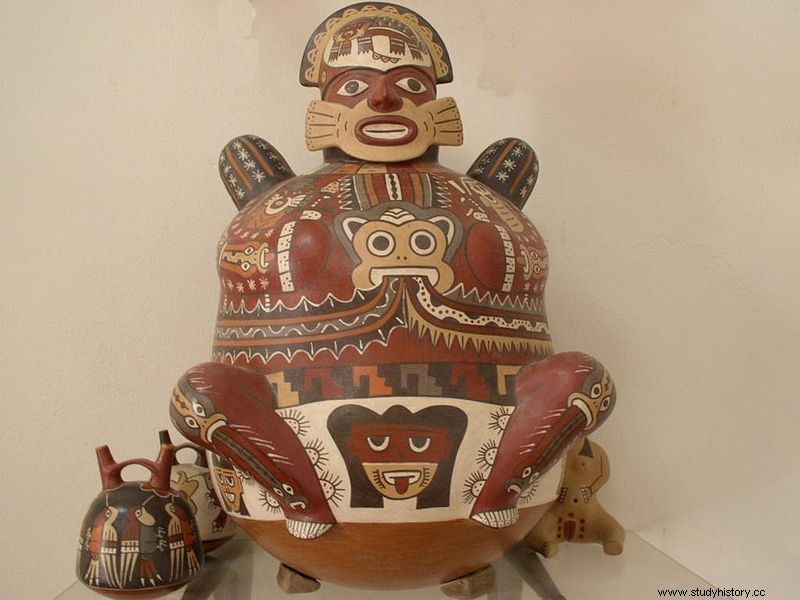
The labor sector was made up of peasants, artisans and fishermen who produced material goods necessary for both the family survival as, mainly, for the benefit of urban specialist technicians. There was a specialization; because certain sectors were dedicated to agricultural activity; others to craft activity and many to fishing. The social relations of production were unequal, for example the priests and soldiers took over the largest amount of products without working, while those who created the wealth were the peasants, fishermen and artisans. “A collective economy subordinated to another, mostly slave, subsisted within the Nasquense social economic formation. There was probably an initial or early slavery; because there was property over land, goods and over men; those who were inclusive, buried with their masters. In addition, the State punished the people by avoiding rebellions or popular uprisings” (Vargas Salgado – 1987).
CULTURAL EXPRESSIONS:
CERAMIC: They assimilated the pre-fired painting (painted before firing) from the Paracas Necropolis period, but intensified the number of colors (they reached eleven) with white, black, yellow, red, gray, etc. standing out. They painted zoomorphic and anthropomorphic figures, in some cases using the entire ceramic surface, thus demonstrating a saturated style of drawings with multicolored tones. The ceramics had a globular shape, a convex base, divergent peaks and a handle-bridge of great beauty. It is said that they did not use the blue color out of respect for the bluish sea, deified and known by the name of Kon. All this work was carried out by thousands of artisans; they molded, painted and baked for ceremonial purposes and benefit of the nobility.
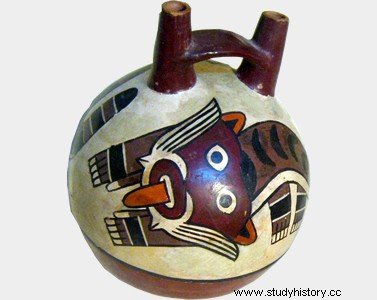
On the surface of their ceramics they painted a variety of drawings with a very fine luster. special. They painted and decorated the entire ceramic surface without leaving blank spaces, which is why it is said that they had a "horror of emptiness". It is considered the best pictorial pottery of Ancient Peru. They made various representations on the surface of their pottery. They represented activities and realistic things such as pacae, corn, deer, frogs, monkeys, fish, cats, birds, killer whales, etc. They also represented their various divinities such as the demon cat god, the boto god (dolphin or killer whale) and the flying feline. In some representations men and divinities appear carrying trophy heads.
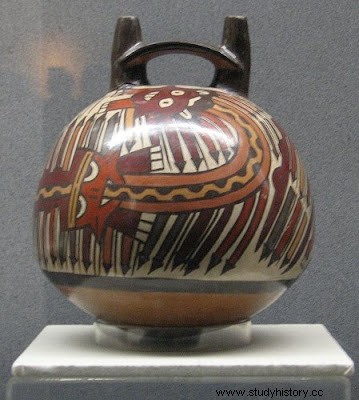
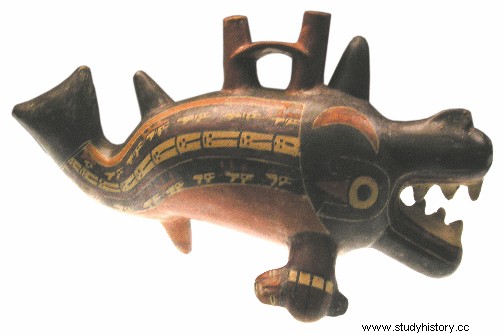 Nazca ceramics depicting a whale ARCHITECTURE: The common man of Nazca used the wood, the adobe and the bark of the trees of the territory where he lived, to build experiences and / or ceremonial centers. The deserts in Ica and Arequipa are not only sand and heat, they are also home to small forests of trees such as huarango, which produces very strong wood. The Nazcas used it to choose poles, as stated in the stake (240 poles that were possibly used as an astronomical observatory). With the earth mixed with water, they made adobe bricks to build sanctuaries for the nobility – as a tribute to the State – in the form of a truncated pyramid. An example of this is the huaca uhle, huaca Tello and the cities of Tinguiña and Cahuachi. These last two are examples of urban planning; the first, constitutes the best architectural expression; the second, considered the capital of Nazca.
Nazca ceramics depicting a whale ARCHITECTURE: The common man of Nazca used the wood, the adobe and the bark of the trees of the territory where he lived, to build experiences and / or ceremonial centers. The deserts in Ica and Arequipa are not only sand and heat, they are also home to small forests of trees such as huarango, which produces very strong wood. The Nazcas used it to choose poles, as stated in the stake (240 poles that were possibly used as an astronomical observatory). With the earth mixed with water, they made adobe bricks to build sanctuaries for the nobility – as a tribute to the State – in the form of a truncated pyramid. An example of this is the huaca uhle, huaca Tello and the cities of Tinguiña and Cahuachi. These last two are examples of urban planning; the first, constitutes the best architectural expression; the second, considered the capital of Nazca.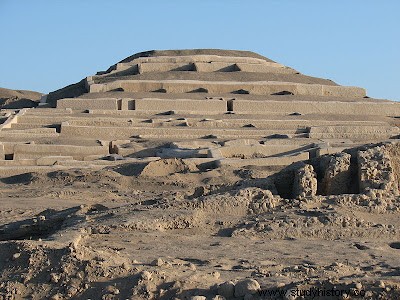 Cahuachi, capital city of Nazca The Nazca built small cities, which is a manifestation of their urban development. They used stone, conical adobes made by hand, reeds and quincha as material for their constructions. Cahuachi, the capital of the Nazca culture, was built with conical adobes. The city is made up of a series of buildings in the form of truncated pyramids, many of which are covered with alluvial material, so its true dimension can only be seen from the air. The building that stands out the most is the construction called "Great Temple", a 20m high pyramid. Administrative and ceremonial activities were carried out in the city
Cahuachi, capital city of Nazca The Nazca built small cities, which is a manifestation of their urban development. They used stone, conical adobes made by hand, reeds and quincha as material for their constructions. Cahuachi, the capital of the Nazca culture, was built with conical adobes. The city is made up of a series of buildings in the form of truncated pyramids, many of which are covered with alluvial material, so its true dimension can only be seen from the air. The building that stands out the most is the construction called "Great Temple", a 20m high pyramid. Administrative and ceremonial activities were carried out in the city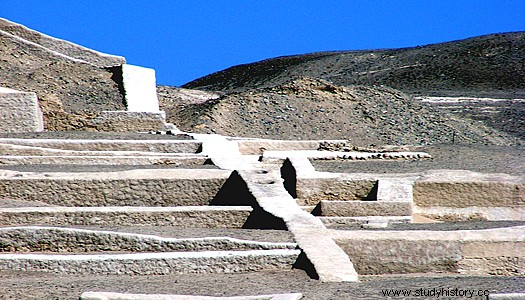
La Estaquería was another Nazca construction. It is a construction made up of a quadrangular platform of adobes; and on the surface it presents lines of carob or huarango posts that supported a roof. It was a ceremonial center that would have served as a rest for the pilgrims who came to practice ceremonies in the Nazca geoglyphs.
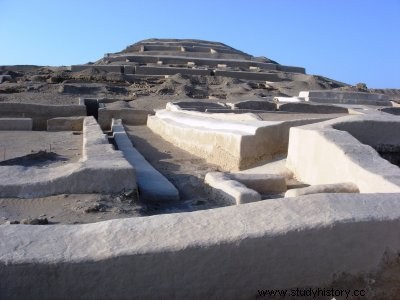
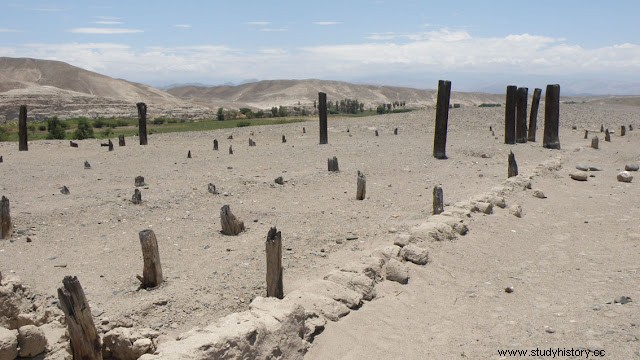 The Estanquería construction of the Nazca "NASQUEN ASTRONOMY" GEOGLYPHS: Thousands of people passed through the pampas of Nazca, Hoscos, Ingenio, San José during the Viceroyalty and the Republic without noticing that, on the ground, the lines had figures of birds, fish, human beings, geometric lines, spirals, etc. The large size of the geoglyphs (graphics on the ground) makes it impossible to see the full figure of a monkey (90m), a hummingbird (120m), a heron, a spider, a dog, etc.; For this reason, Julio C. Tello's assistant, Toribio Mejía Xesspe (discoverer), when reconnoitering the area in 1927, assumed that they were the remains of sacred roads. Paúl Kosok continued scientific studies -1939- he spotted them from an airplane in flight and when studying them he maintained that the geoglyphs had shapes of zoomorphic, anthropomorphic and geometric figures. The young German mathematician, María Reiche, (who is known as the " lady of the pampa”) who accompanied Kosok was amazed at these geoglyphs – 1941 – and decided to stay to investigate them; for this she moved from Cusco to Lima and then to Ica. She became, then, in this way, the most interested and patient student (five decades of patient work). She proposed that the figures are part of an astronomical calendar, the largest in the world, made in the form of channels on the ferrous and clayey soil.
The Estanquería construction of the Nazca "NASQUEN ASTRONOMY" GEOGLYPHS: Thousands of people passed through the pampas of Nazca, Hoscos, Ingenio, San José during the Viceroyalty and the Republic without noticing that, on the ground, the lines had figures of birds, fish, human beings, geometric lines, spirals, etc. The large size of the geoglyphs (graphics on the ground) makes it impossible to see the full figure of a monkey (90m), a hummingbird (120m), a heron, a spider, a dog, etc.; For this reason, Julio C. Tello's assistant, Toribio Mejía Xesspe (discoverer), when reconnoitering the area in 1927, assumed that they were the remains of sacred roads. Paúl Kosok continued scientific studies -1939- he spotted them from an airplane in flight and when studying them he maintained that the geoglyphs had shapes of zoomorphic, anthropomorphic and geometric figures. The young German mathematician, María Reiche, (who is known as the " lady of the pampa”) who accompanied Kosok was amazed at these geoglyphs – 1941 – and decided to stay to investigate them; for this she moved from Cusco to Lima and then to Ica. She became, then, in this way, the most interested and patient student (five decades of patient work). She proposed that the figures are part of an astronomical calendar, the largest in the world, made in the form of channels on the ferrous and clayey soil. María REiche - The Lady of the Pampa “It would be to have a very low opinion of the ancestors, to suppose that all this immense and meticulously accurate and detailed work done with conscientious perfection, had as its sole purpose the service of a primitive superstition or a sterile cult of the ancestor. On the contrary, we have here the testimony on a large scale and unique in the world of the first awakening of the exact sciences in the evolution of humanity, a gigantic effort of the primitive mind that is reflected in the greatness of the execution under the vast cycle of immense and solitary pampas swept by the wind and burned by the sun.
María REiche - The Lady of the Pampa “It would be to have a very low opinion of the ancestors, to suppose that all this immense and meticulously accurate and detailed work done with conscientious perfection, had as its sole purpose the service of a primitive superstition or a sterile cult of the ancestor. On the contrary, we have here the testimony on a large scale and unique in the world of the first awakening of the exact sciences in the evolution of humanity, a gigantic effort of the primitive mind that is reflected in the greatness of the execution under the vast cycle of immense and solitary pampas swept by the wind and burned by the sun.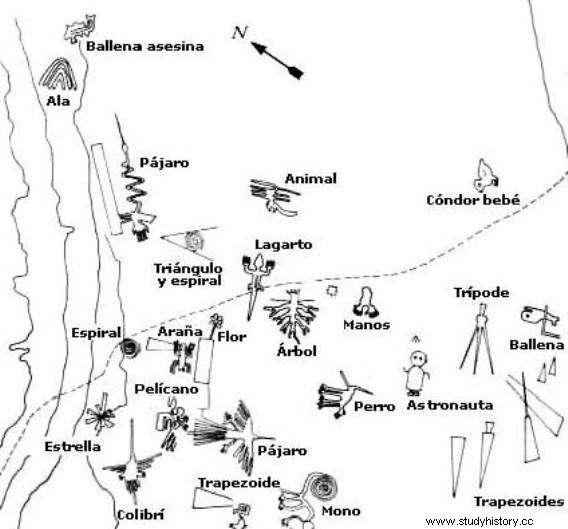
“People who lived long ago left behind a unique document that I believe constitutes an essential chapter in the development of the human mind. There is nothing like it anywhere in the world like the world's largest astronomical calendar." I want to be an instrument to eliminate cultural injustices and for Peruvians and foreigners to learn not to prey on what is the heritage of a nation and, above all, the heritage of an incomparable culture, because culture is the reflection of the idiosyncrasy of the people. ” (María Reiche). María Reiche states about the Nazca lines that they had a “unit of measurement, 33cm, (practically the elbow), with various relationships that probably served as the basis for their execution. Reiche identifies the figure of the monkey with the big bear, which would communicate the arrival of summer, while other figures such as those of the bird, the dolphin, the spider (which may have indicated the stars of Orion) had served to announce the other seasons and the changes that the climate brings with it. In this way, the lines and figures had been drawn to indicate the rising of certain stars and follow their variations, since the constellations do not always appear at the same point in the sky, nor is their movement repeated with the same constancy.
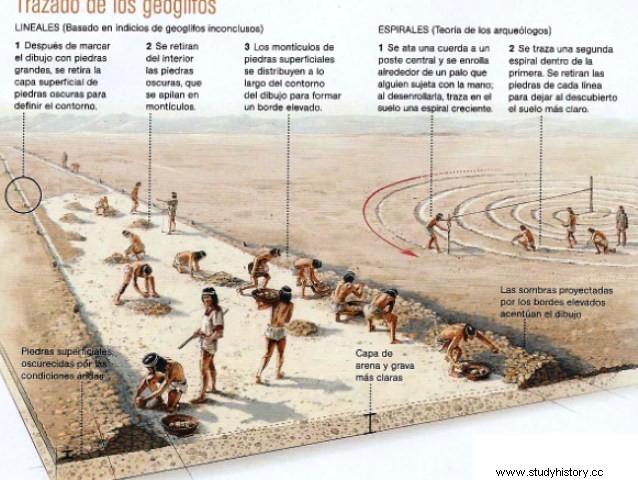 Nazca Geoglyphs “ Those who traced it surely managed to understand the astronomical phenomena and executed their drawings to predict the rainy seasons in the mountains and, consequently, the good or bad possibilities of harvesting. It must have been very important (because the agriculture of the coastal valleys depends on the rains of the mountains) to have certain forms of prediction handled by true specialists, sages or priests of the dominant houses, who must have been in charge of this type of observations and to serve as intermediaries between the divinities that conducted the phenomena of nature and the other members of society (Silva Santiesteban - 1982). The objective of the Nazca man was to carry out an astronomical observation for agricultural purposes to identify times of drought and rain and with This prevents the flooding of the rivers and, therefore, the future production of the coastal valley. María Reiche postulated that this population used a brigade unit baptized by her as "cordel", to achieve accuracy in the lines; she affirmed, also the use of the binary system, logarithmic operations, scales, models and compasses, only with these elements can the representation of these lines be possible, said María Reiche in the seminar on archeology and astronomy (1982) held at the National Library. Other theories have now been proposed. It is argued that these would be lines that represent paths and squares that were traversed in the midst of ritual ceremonies with the aim of promoting rains, taking into account the importance of water for a dry territory.
Nazca Geoglyphs “ Those who traced it surely managed to understand the astronomical phenomena and executed their drawings to predict the rainy seasons in the mountains and, consequently, the good or bad possibilities of harvesting. It must have been very important (because the agriculture of the coastal valleys depends on the rains of the mountains) to have certain forms of prediction handled by true specialists, sages or priests of the dominant houses, who must have been in charge of this type of observations and to serve as intermediaries between the divinities that conducted the phenomena of nature and the other members of society (Silva Santiesteban - 1982). The objective of the Nazca man was to carry out an astronomical observation for agricultural purposes to identify times of drought and rain and with This prevents the flooding of the rivers and, therefore, the future production of the coastal valley. María Reiche postulated that this population used a brigade unit baptized by her as "cordel", to achieve accuracy in the lines; she affirmed, also the use of the binary system, logarithmic operations, scales, models and compasses, only with these elements can the representation of these lines be possible, said María Reiche in the seminar on archeology and astronomy (1982) held at the National Library. Other theories have now been proposed. It is argued that these would be lines that represent paths and squares that were traversed in the midst of ritual ceremonies with the aim of promoting rains, taking into account the importance of water for a dry territory.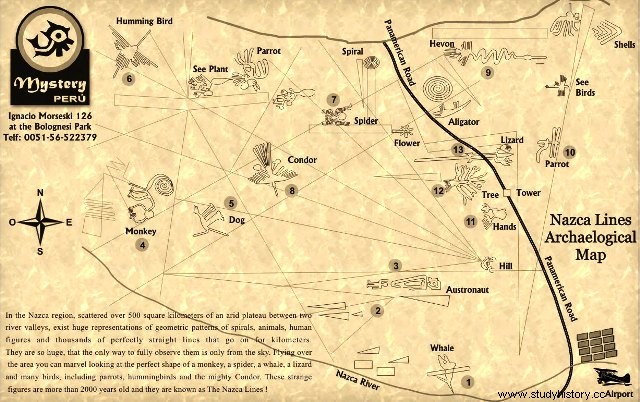
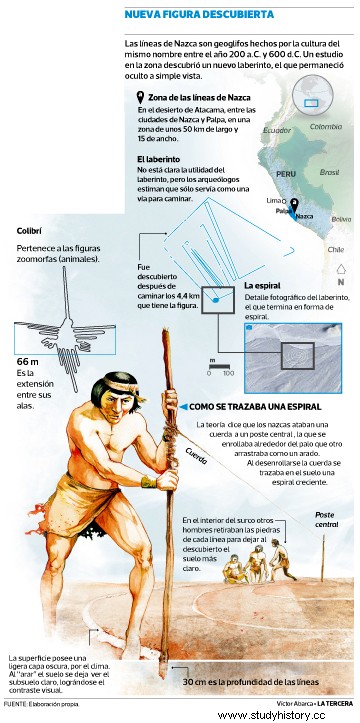
THE ENIGMAS OF THE NAZCAS
